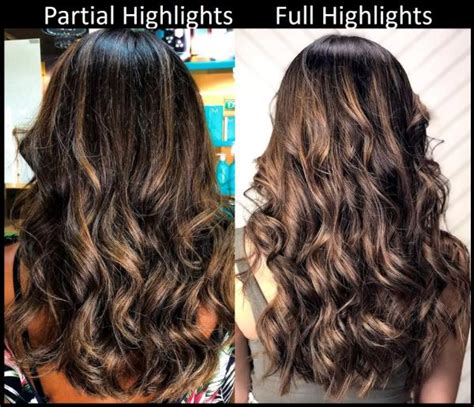Introduction
Highlighting hair is a popular technique used to enhance hair color and texture. Whether you opt for partial or full highlights, both methods offer distinct advantages and considerations. In this article, we explore the nuances of partial and full highlights, providing a comprehensive guide to help you make an informed decision.

Partial Highlights
Principles: Partial highlights involve selectively lightening portions of hair, typically around the face and crown. This technique creates a natural, sun-kissed effect that adds dimension and depth to hair.
Benefits:
- Natural Look: Partial highlights mimic the natural effects of sun exposure, giving hair a gradual, blended appearance.
- Lower Maintenance: Since only a portion of hair is highlighted, partial highlights require less maintenance than full highlights.
- Versatile: Partial highlights can be tailored to suit any hair type and length, from fine to thick and short to long.
Pain Points:
- Limited Impact: Partial highlights may not be as dramatic as full highlights, especially on darker hair colors.
- Root Touch-Ups: As hair grows, roots will need to be touched up more frequently than with full highlights.
Full Highlights
Principles: Full highlights involve lightening every strand of hair, creating an overall brighter and more uniform color. This technique is often used for bolder transformations or to cover gray hair.
Benefits:
- Dramatic Transformation: Full highlights provide a significant change in hair color, making them ideal for those seeking a drastic shift.
- Uniform Coverage: Every strand of hair is lightened, ensuring complete coverage and minimal fading.
- Gray Hair Coverage: Full highlights are an effective solution for covering gray hair, giving hair a more youthful appearance.
Pain Points:
- Higher Maintenance: Full highlights require regular touch-ups every 6-8 weeks to maintain their vibrancy.
- Damage Potential: Bleaching the entire head of hair can lead to increased dryness and potential damage.
- Cost: Full highlights are generally more expensive than partial highlights.
Comparison Table: Partial vs. Full Highlights
| Feature | Partial Highlights | Full Highlights |
|---|---|---|
| Lightened Hair | Portions | Every Strand |
| Effect | Natural, Sun-Kissed | Dramatic, Uniform |
| Maintenance | Lower | Higher |
| Versatility | Can suit any hair type and length | May not suit all hair types |
| Root Touch-Ups | More frequent | Less frequent |
| Cost | Lower | Higher |
Motivations for Highlighting Hair
- Enhance Hair Color: Highlights add depth and dimension to hair, making it appear thicker and fuller.
- Cover Gray Hair: Highlights can effectively blend or conceal gray hair, restoring a more youthful appearance.
- Create a New Look: Highlights can instantly transform your overall look without drastically changing your hair color.
- Personalize Hair: Highlights allow for customization to complement individual features and preferences.
Common Mistakes to Avoid
- Over-Highlighting: Excessive highlighting can damage hair and lead to breakage.
- Wrong Shade: Choosing a highlight shade that doesn’t complement your natural hair color can create an unnatural or unflattering effect.
- Improper Care: Neglecting to use color-protecting products and practicing proper hair care can cause highlights to fade prematurely.
Why Highlight Matters
- Confidence Booster: Highlights can enhance your appearance and give you a boost of confidence.
- Versatility: Highlights can be tailored to suit any hair color, texture, and style.
- Low-Commitment: Partial highlights are a low-commitment way to experiment with different looks without making a permanent change.
- Endless Possibilities: Highlights can be used to create an array of effects, from subtle to bold.
Benefits of Highlighting Hair
- Adds Dimension: Highlights enhance hair’s depth and texture, making it appear thicker and more vibrant.
- Rejuvenates Hair: Highlights can restore dull, lifeless hair, giving it a youthful and radiant glow.
- Customizable: Highlights can be tailored to create unique and personalized looks that complement individual features.
- Less Damage: Partial highlights cause less damage to hair compared to full highlights, making them a healthier option.
Applications of ‘Highlighting’ Beyond Hair
The concept of ‘highlighting’ can be creatively applied to various domains beyond hair:
- Medicine: Targeted highlighting can be used for precise diagnosis and treatment in medical imaging.
- Education: Highlighting key points and concepts in textbooks and study materials enhances comprehension.
- Marketing: Highlighting specific features or benefits of a product or service can increase its appeal to consumers.
- Art: Highlighting certain areas of a painting or sculpture can emphasize depth, perspective, and visual impact.
Conclusion
Both partial and full highlights offer distinct advantages and considerations. Partial highlights provide a natural, low-maintenance effect, while full highlights create a more dramatic and uniform transformation. Ultimately, the best choice depends on your individual hair type, style preferences, and desired level of maintenance. With careful consideration and proper care, highlights can enhance your hair’s appearance and boost your confidence.
